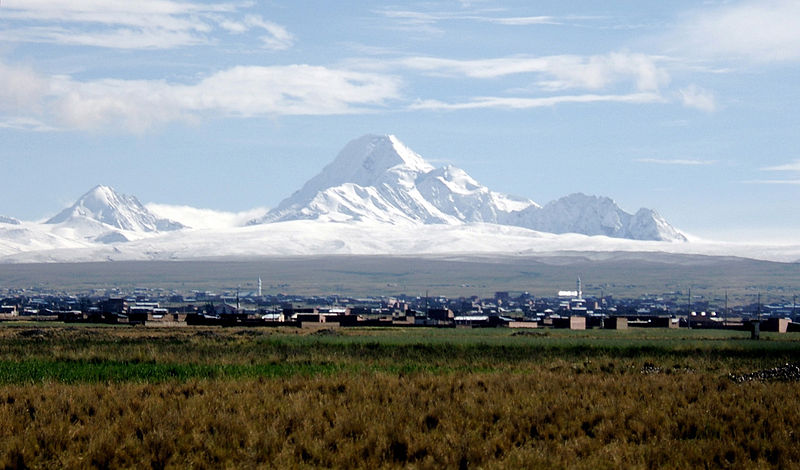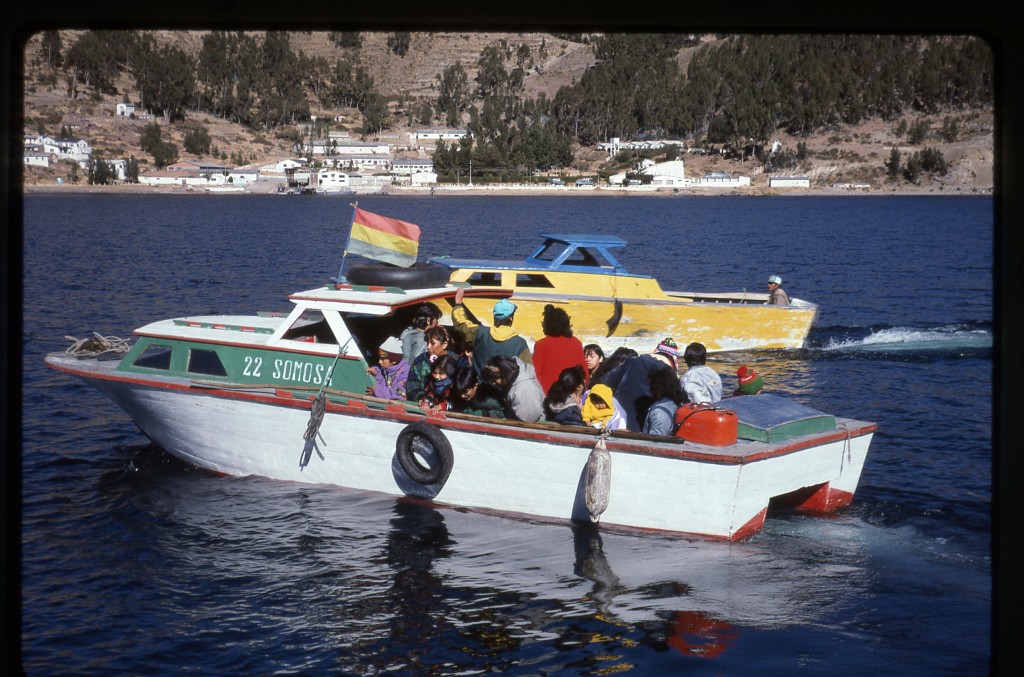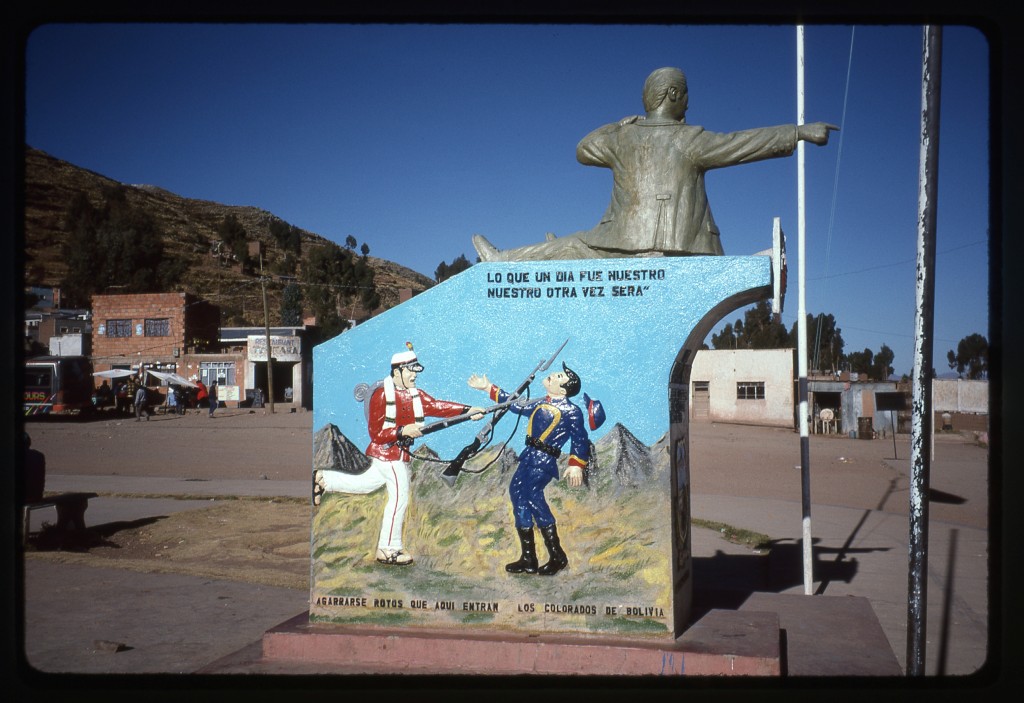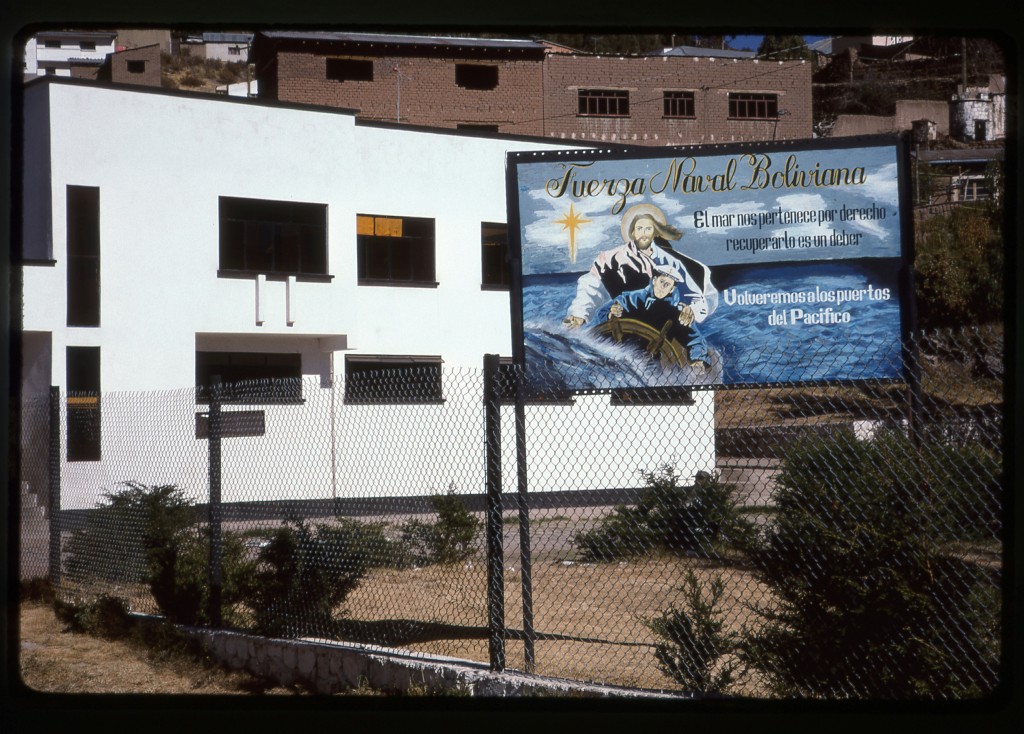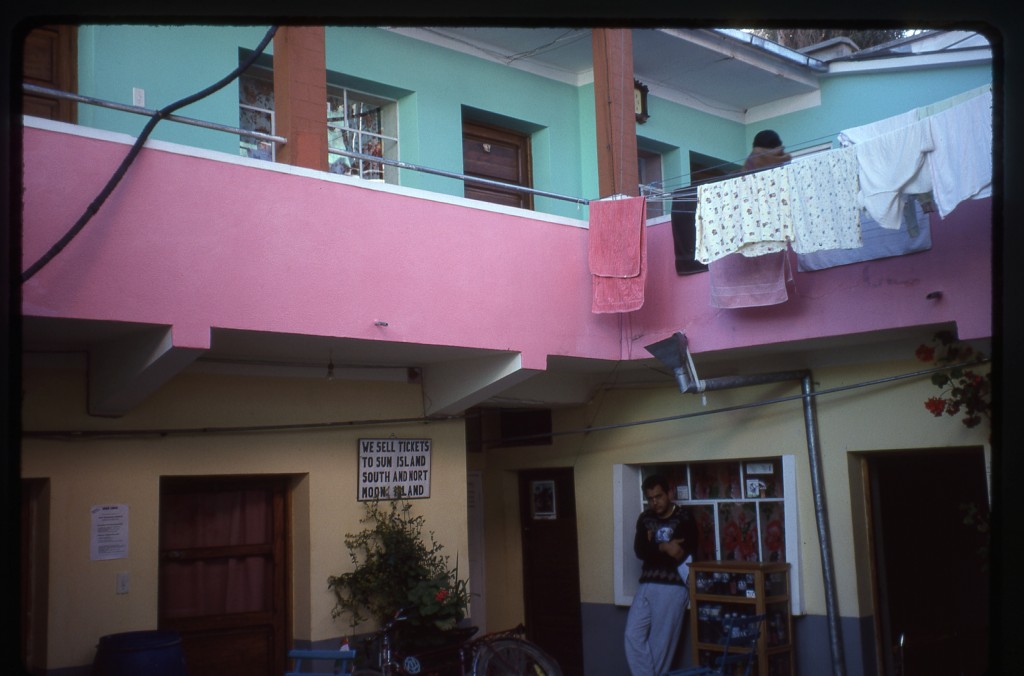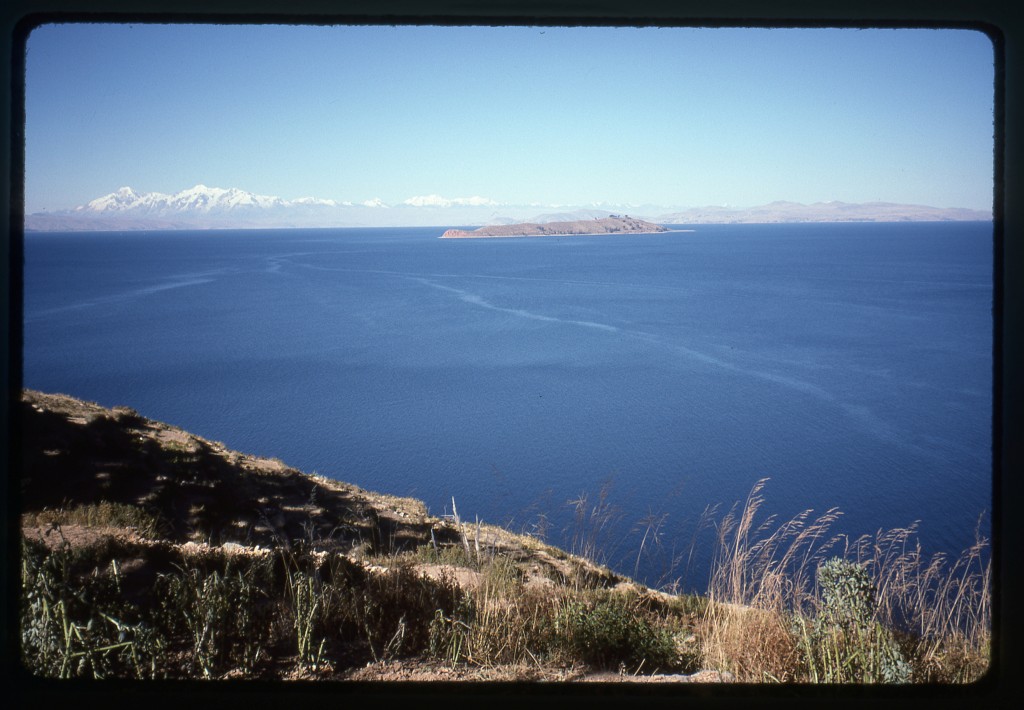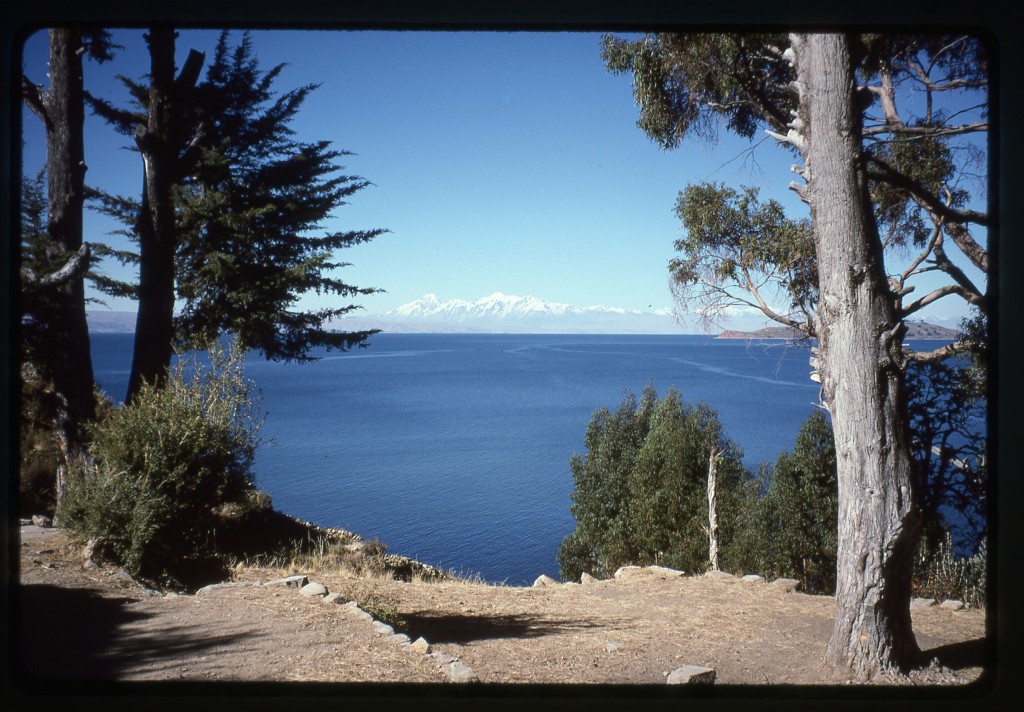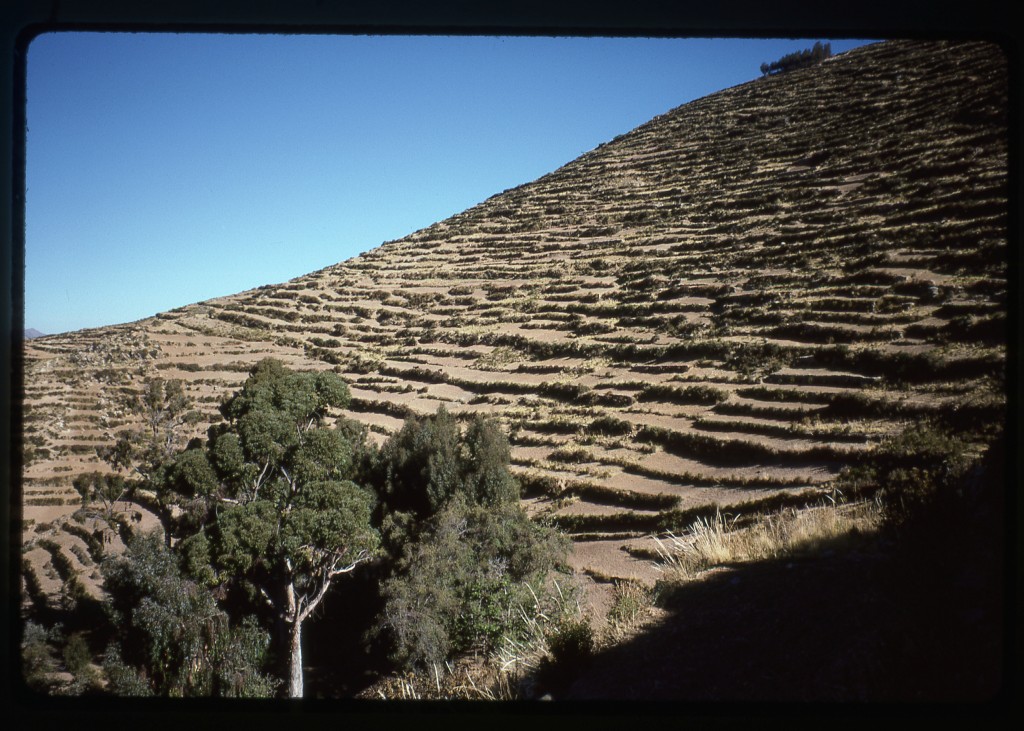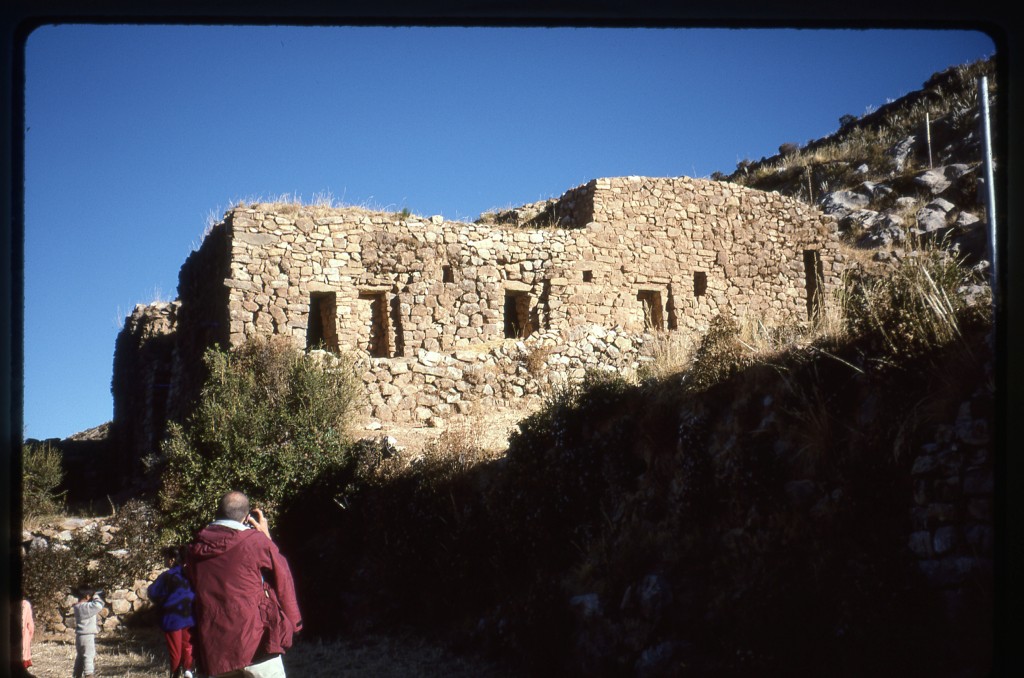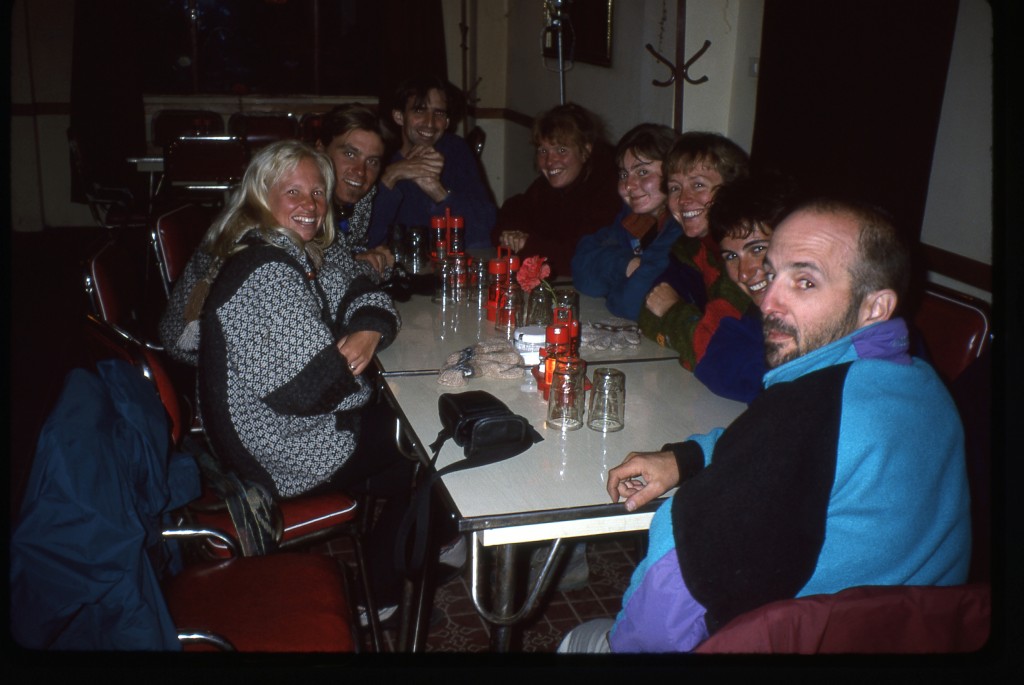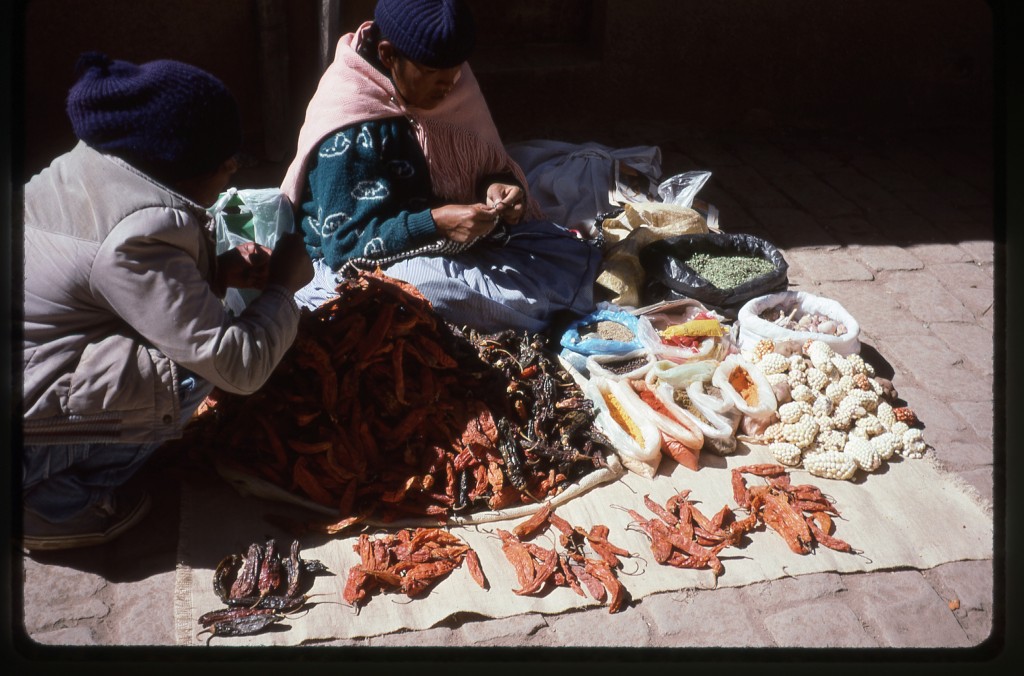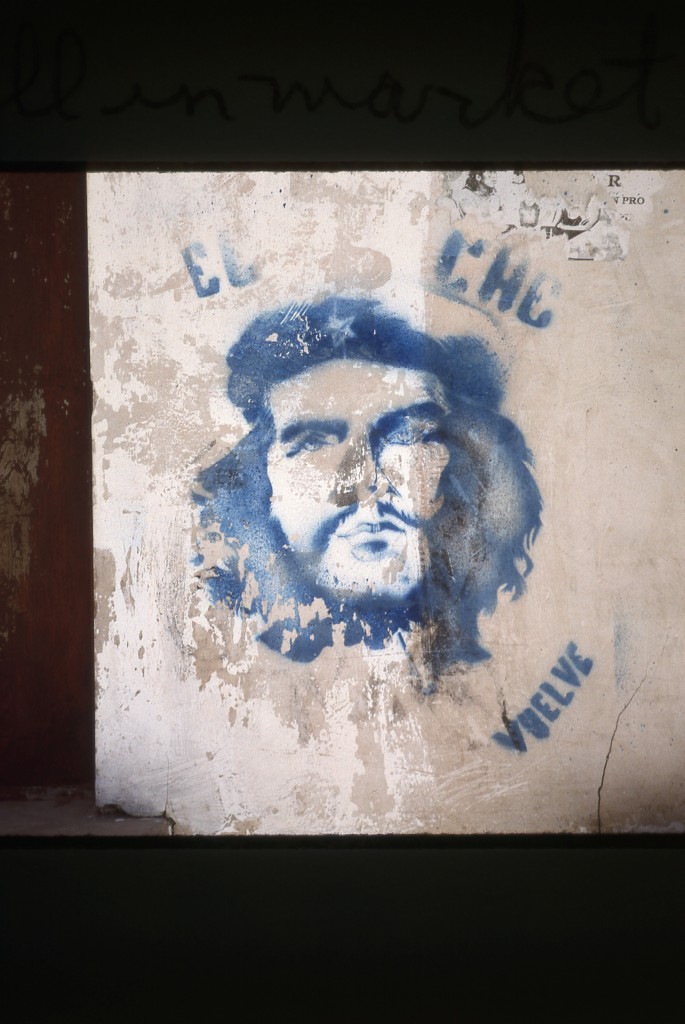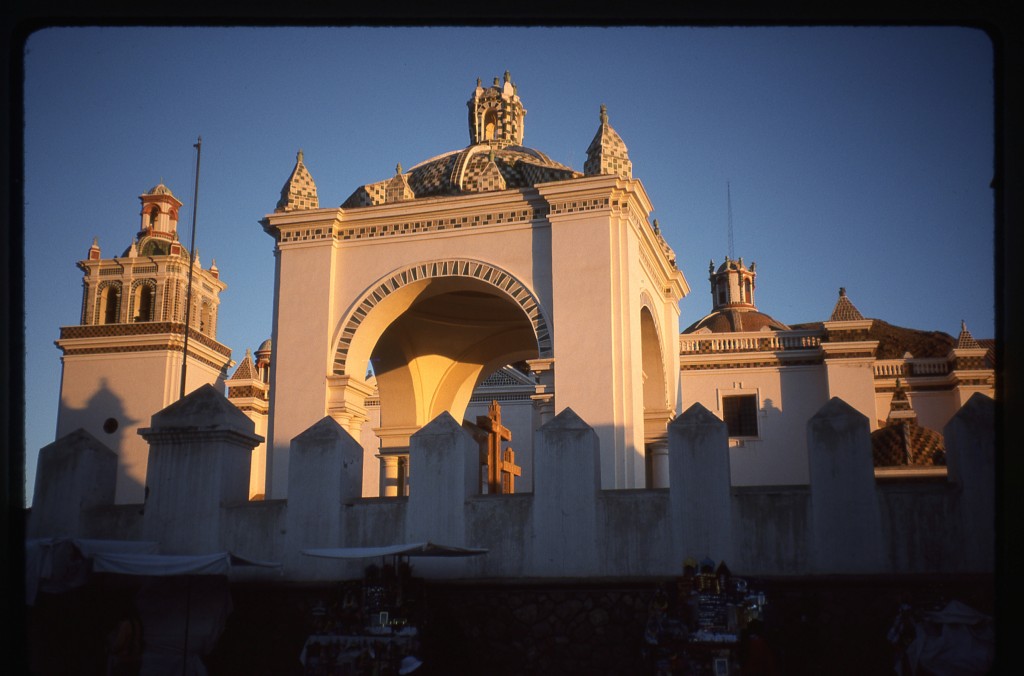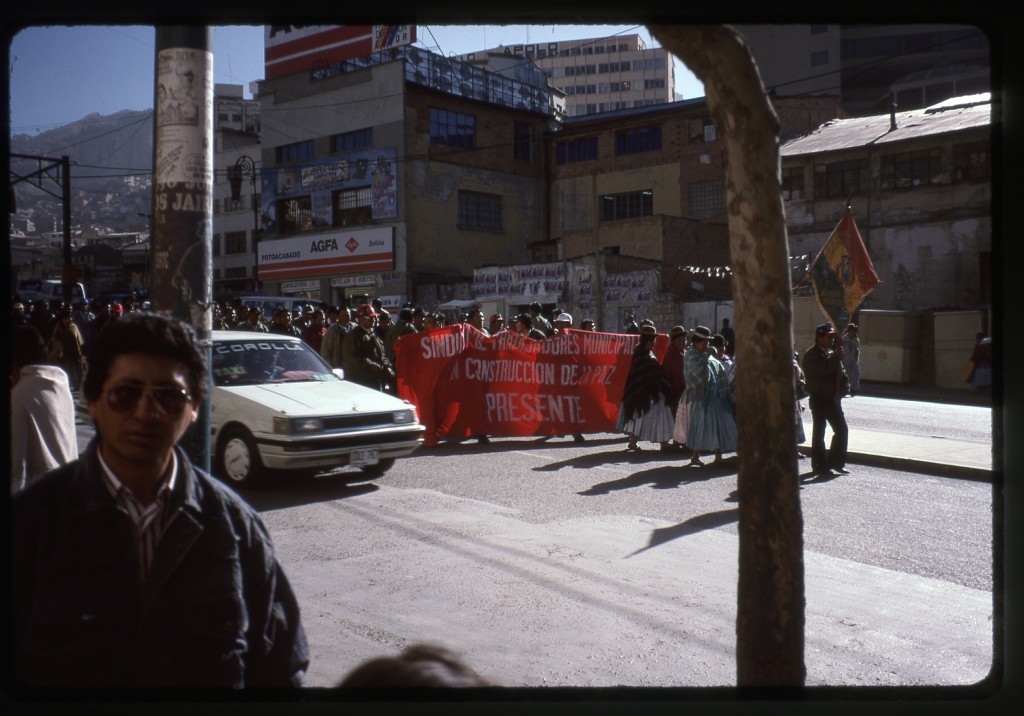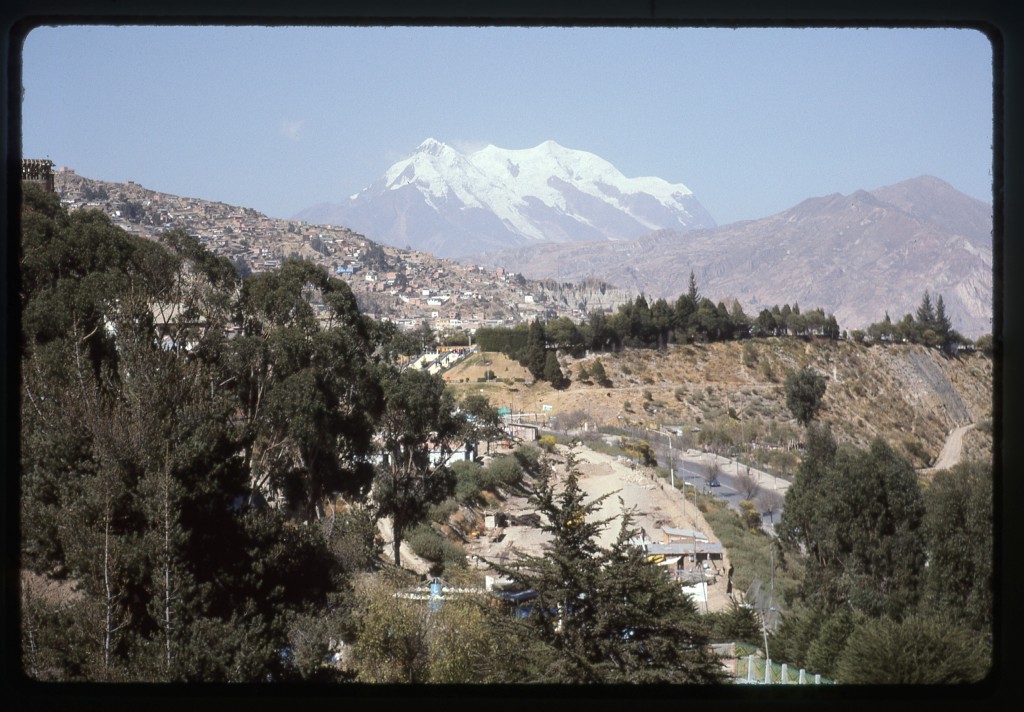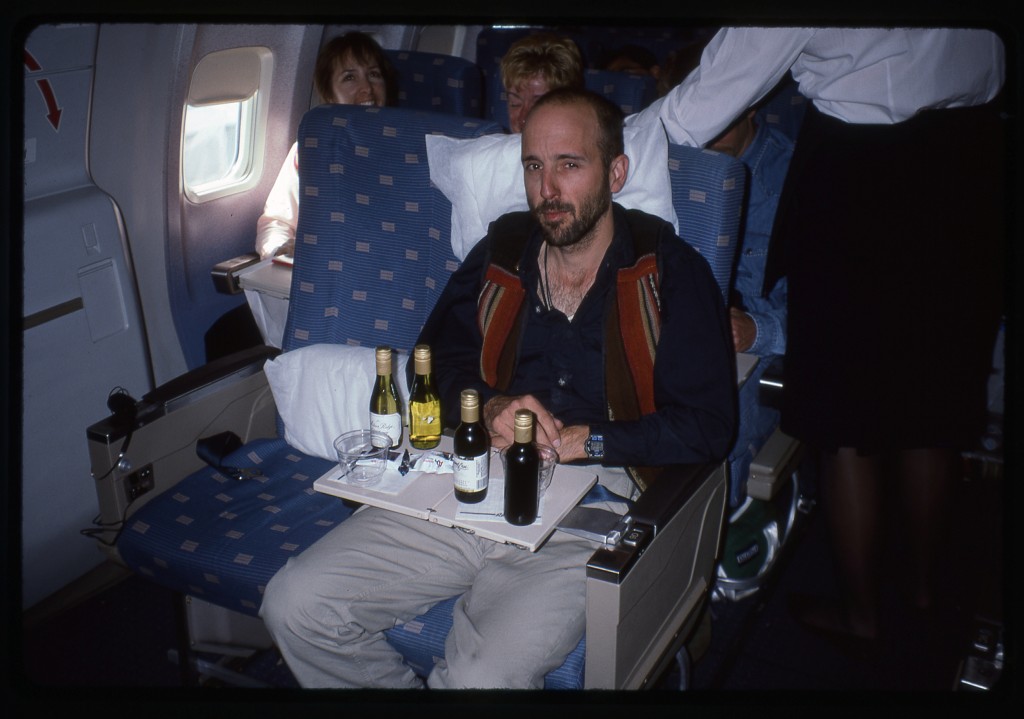Today we were tourists, nothing more. One important thing we had to do was to get to a post office, where we bought, wrote and mailed postcards. We then went to Entel, a place where we could make international phone calls. It had been 11 days that we had been incommunicado. My wife was relieved to hear that we were safely back from our climbing. In her place, I would have been worried sick. We spent a leisurely day, eating in restaurants and shopping for souvenirs.
In the evening, we arranged with Susan, the travel agent who had an office in our hotel, two bus tickets to Lake Titicaca. The hotel agreed to store all our gear for us while we were gone. Only three days left in this amazing country before we were to fly home.
At 7:30 a.m. the next morning, a minibus arrived for us and took us to the Hotel Rosario where we switched to a larger bus. Through busy city streets up to the Altiplano, to the countryside where we passed through a series of small villages.
After what seemed like endless military checkpoints, we finally arrived at a place called Tiquina. For the sum of one Boliviano each (one Boliviano is worth about 19 cents in U.S. funds), we crossed a strait in a motorboat.
Bolivia has fought wars with its neighbors, losing them all, and chunks of its territory in the process. It still holds a bitter grudge over these losses, and a monument at Tiquina illustrates this. It shows a Bolivian soldier stabbing a Chilean through the neck with his bayonet. The wording on the wall says “What was ours will be ours again”. Since Bolivia no longer has any ocean coastline, its navy is now reduced to patrolling Lake Titicaca.
Not to put too fine a point on it, but here’s another picture I just had to show you. At Tiquina, the Bolivian navy has a small base, and this sign is proudly displayed there. It reads: “Bolivian Navy: By right, the sea belongs to us; it’s our duty to take it back. We’ll get back our ports on the Pacific.” And the picture shows a Bolivian sailor piloting a boat with Jesus watching over him.
Once on the other side of the strait, endless annoying rough dirt-road detours finally brought us to our destination, the small town of Copacobana, less than five miles from the Peruvian border, at around noon.
We were quickly steered in the direction of the Alojamiento Emperador, where, for the sum of 8 Bolivianos each per night (a buck fifty-two), we had a nice, clean, basic room. It wasn’t fancy, but it was a fun, funky place filled with fascinating travelers from all over the world.
Not wasting any time, we arranged tickets for 20 Bolivianos each for the launch that would take us out on to the lake. For 5 Bolivianos more, we each grabbed a hot lunch to go, en route to the boat. After a short wait at the dock, we headed out for the 1 1/2-hour trip to Isla del Sol. Lake Titicaca is 118 miles long, and sits at an elevation of 12,500 feet above sea level. The lake is so huge that there’s nothing to really give you a sense of how high in elevation it is.
Isla del Sol is a beautiful spot, brimming with archaeological sites and natural beauty. Once we arrived on the south side of the island, a long set of stairs awaited us. This staircase is aptly called the “Escalera del Inca”, and at its top is the Fuente del Inca. This fountain is actually three separate spouts of water, which it is said date back to pre-Columbian times when the Inca people lived here.
The higher one climbs on the island, the more spectacular the views become.
These terraces were installed by the Inca to maximize the agricultural possibilities and are still important today, as agriculture and tourism are the mainstays of the 3,000 inhabitants of the island.
After a while spent there, we went back to the boat and continued around the island some distance to the site of the Pilko Kaina ruins. I don’t know the age of these ruins, but others nearby have been dated to 2,200 BC. The fact that they are still standing centuries later is a testament to how well they were constructed, even more so when you consider that no mortar was used.
Once back on the boat, it was a pleasant ride to the mainland and Copacabana. At the Emperador, we met some amazing people who were also staying there. A British couple was riding a tandem bike across the Altiplano, but, amazing as that was, it paled in comparison to a young Turkish woman, a photojournalist by the name of Hulya Koc. She had already ridden her bicycle the entire length of South America from north to south, and was repeating her journey in reverse when we met her. And she was doing all of that solo! Now that’s what I call an adventuring spirit. In the company of these and other travelers, we all headed out to a little bar for a few beers. After that, to a restaurant for a terrific trout dinner, a local favorite straight from the icy waters of Titicaca. This full-blown dinner cost a whopping three bucks.
We closed the place down, then went looking for dessert. Not finding any, back we went, all nine of us, to the bar and closed it down too.
For a town of only 6,000 inhabitants, it was surprising for us to chance upon a nice vegetarian restaurant such as the Cupola for breakfast the next morning. We then spent a few lazy hours wandering the town, enjoying the open-air market and street scenes.
Che Guevara was an Argentine who helped the Cuban revolution, and was later executed in Bolivia. He is still, to this day, revered here as a native son.
A visit to Copacabana wouldn’t be complete without a visit to its famous cathedral. Begun in 1605, it was a tranquil oasis in the middle of the town. Its world-famous statue of the Virgin was carved in 1580.
The trout was calling us, so we went back to last night’s restaurant and enjoyed another feast. Trout was so popular here that they served it fifteen different ways. Sated with fish and beer, we boarded our bus and were soon back in La Paz. A lazy rest of the day seemed in order, so we took it easy. Learning more about the Hostal República in which we were staying, it turns out that had been owned by a guy named Pando, who had been the President of Chile in 1904. His great-grandson now owned it. At $11.00 U.S. per night each, it was almost eight times more costly than our room in Copacabana, but still a pleasant refuge in the capitol. And they did take awfully good care of us, so that was worth something in itself.
After a good night’s sleep, we headed out for a day of walking and sightseeing in the city. Something that caught our eye was a loud group of demonstrators marching by – it turned out that they were protesting layoffs by the city government.
The vegetarian lunch buffet at the Gloria Hotel was worth waiting for, and the two dollar price didn’t hurt any either. More walking and shopping filled out the afternoon, along with writing and mailing postcards to friends in several countries. Tomorrow we would depart Bolivia.
The next morning, July 6th, dawned clear and cool. Our wake-up call came at 4:45 a.m. Having paid our bill the prior evening, all we had to do was haul our gear to the front door where our cab was already waiting. Since it was a Saturday, and so early, the streets were deserted and our driver made good time to the airport. We were among the first to check in, and our flight was airborne right on time, at 7:15. Much to our surprise, instead of heading north to the U.S., we flew in a nearly-southeasterly direction for a short while and landed in Santa Cruz. This city is as large as La Paz, sits at only 1,365 feet above sea level, and is the major economic center of the country. We spent an hour sitting on the bleeding tarmac while a crew change occurred, then off we went once again, this time heading in the proper direction.
Barely airborne, the flight attendant gave us each a glass of champagne, which we inhaled. Then came the wine, free of course – we each got two little bottles, which we thoroughly enjoyed. With lunch, we each had another bottle – I can assure you, we were feeling no pain.
I dozed off for much of the flight, and we finally touched down at around 4:00 p.m. in Miami. Although we stood in line for an hour to clear U.S. Immigration, we were cleared without incident. I got my bag and went through U.S. Customs quickly (Brian had checked his through to Toronto). I re-checked my bag and got seat assignments for my flights, then we sat and had a coke. Then it was time to part ways, so we said a heartfelt goodbye. This entire adventure had spanned a mere 16 days, With no mishaps, we had visited an amazing country with beautiful people. and had done some great climbing in the process. Now, over 17 years later, I fondly think back on the whole experience and daydream of all the mountains I’d still like to climb there.
You can also visit us at our Facebook page at: https://www.facebook.com/pages/Desert-Mountaineer/192730747542690

